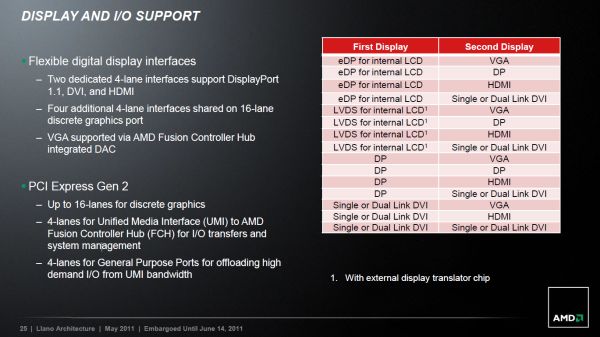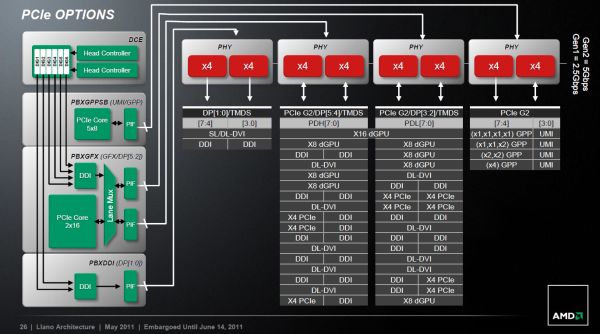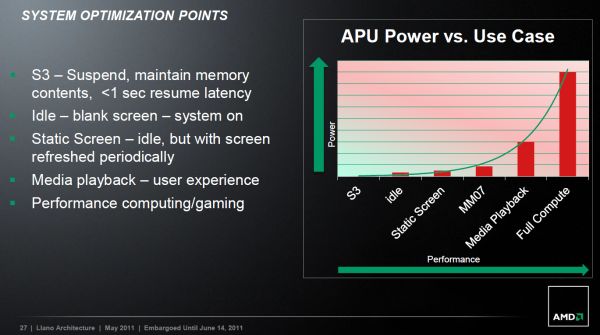Desktop Llano Motherboards: The ASRock A75 Extreme6 Preview
by Ian Cutress on June 14, 2011 12:00 AM EST- Posted in
- Motherboards
- ASRock
- Llano
It's been a while since we've discussed AMD motherboards at AnandTech—over the next few months, I am hoping to bring them back. To start, we have our first Desktop Llano product on the test bed—the ASRock A75 Extreme6. Unfortunately, what I've been testing is still 'a work in progress'—so there are issues with the BIOS and design still to be decided. For now I'll let you know what I've found, in terms of performance and design. But when the full board comes my way with release information, I'll post a full review.
The desktop Llano series is the mainstream jewel in the AMD calendar. As Anand has discussed, the Fusion APU architecture of AMDs plan is split between the Brazos platform (with Ontario and Zacate) of sub 18W processors with Bobcat cores, and the Lynx platform (with Llano) for 25-100W processors. The former has 1-2 Bobcat cores, whereas with Llano we're dealing with 2-4 K10 cores.
In terms of motherboard design, the Llano processors absorb any form of Northbridge, and the motherboard will use a series of 'Fusion Controller Hubs', codename Hudson. The desktop version will use the Hudson-D series Fusion Controller Hubs, with the A75 Desktop 'Lynx' models under the Hudson-D3 header. The main selling points will be the six native SATA 6 Gbps ports and the four native USB 3.0 ports.
The Lynx platform comes up with some interesting points: hybrid CrossfireX with any 6-series GPU and the APU, native USB 3.0 and SATA 6 Gbps, and dual channel DDR3-1866 native support. Here's some comparisons with P67:
| Hudson-D3 | P67 | |
|---|---|---|
| Codename | Lynx (Desktop) | Sandy Bridge |
| SATA 6 Gbps + 3 Gbps | 6 + 0 | 2 + 4 |
| Memory Support | DDR3-1866 | DDR3-1333 / 2133 OC |
| PCIe | 16x or 8x/8x | 16x or 8x/8x |
| RAID | 0,1,10 | 0,1,5,10 |
| USB 3.0 + 2.0 + 1.1 | 4 + 10 + 2 | 0 + 14 + 0 |
| Display Output |
VGA + 1 dedicated / 4 shared (HDMI/DVI/DP) from APU |
VGA + 3 HDMI/DVI/DP |
| FIS-Based Switching | No | Yes |
| Overclocking | Clock | Multiplier |
For displays, two four-lane interfaces are dedicated for Display Port 1.1, DVI and HDMI—but various combinations aren't possible:
AMD are keen to point out the power consumption curves generated by the gating of the processor and system, depending on various sleep states—citing a one second recovery from S3.
But alas, most of the hype regarding Fusion and Llano is CPU based. In terms of the motherboard, it's up to the designers to get creative, so let's take a look at the ASRock A75 Extreme6.













43 Comments
View All Comments
IanCutress - Tuesday, June 14, 2011 - link
Core i3 Second Generation chips are dual cores with hyperthreading (2C/4T). 2500K is 4C/4T. It's not a straight 50% as you make it out to be, otherwise the i7-920 (4C/8T) would act the same or worse than the 2500K (due to instructions per clock and clock speed).duploxxx - Tuesday, June 14, 2011 - link
it doesn't matter if you want to compare it to i3 or i5. If AMD puts a price on this Liano and it targets i3 then one should compare with i3, graphics performance there is nothing to compare against from Intel only discrete anyway.L. - Tuesday, June 14, 2011 - link
Although this battle looks a bit heated, I'll be joinin on the fun :pQuite seriously, Llano is not meant to be compared with anything else than SOC systems, and I believe as soon as we have pricing information, it'll be a clear winner.
i3 is still an "overpowered" CPU compared to most everyone's needs, with a clearly underpowered GPU compared to any basic gaming needs.
The good comparison for the Llano will be : xyz watts, zyx dollars for the base SOC system.
I believe anything like discrete graphics does not fall in the same category and would thus be nonsense, unless it falls in the extremely unlikely case of same tdp, same price and better performance, where it'll still have the big disadvantage of not being SOC.
Clearly any comparison with an i5 is purely informative, as the i5-2500k is an overkill CPU for (almost) everything and thus of limited interest to most customers (as in, drop that i5 and it's expensive mobo, drop the 6870, get a cheap phenom crap and an hd6950 and there you go, better results).
Quite curious as to how much the base combo with Llano will cost and consume, mini-ITX 4 gigs of RAM looks like plenty for that type of SoC.
jrs77 - Tuesday, June 14, 2011 - link
Llano seems to lack CPU-performance like we expected and excels in video-performance compared to SandyBridge.The question is, just how much video-performance Joe Black needs on a daily basis.
If Llano isn't way cheaper then intels i3-2xxx and doesn't use less power, then there's imho no reason to go for AMD. And intel can easily upgrade their small desktop-chips from HD2000 to HD3000 to improve the iGPU drastically.
I'm not impressed actually.
medi01 - Wednesday, June 15, 2011 - link
Did you take motherboard cost into account?I simply cannot imagine users that would benefit from a bit higher raw CPU performance CPU of i3 level more than from a vastly superior video/3D performance.
psychobriggsy - Tuesday, June 14, 2011 - link
Can you confirm why you are using Catalyst 10.12 in this day and age, when Llano requires 11.4 or higher? Or is that a cut-and-paste mistake?Also can you try using DDR-1833 with Llano next time - I don't know why you've downclocked the fast memory that is used in this preview - a limitation with the ES Llano you're using?
IanCutress - Tuesday, June 14, 2011 - link
Catalyst 10.12 was used for the discrete GPU results in the test, the drivers on the support CD were used for the iGPU tests. Using Catalyst 10.12 allows us to retain parity with the other products we've tested this year - particularly when improved Crossfire profiles are released, it would be unfair to compare similar products with wildly different Catalyst versions if the latest has a significant performance increase. Every time we change Catalyst versions, I will have to go back and test a few previous boards in order to have some comparison points for the future. That being said, we may move to 11.6 when it is released.Also the same thing with memory - in order to retain parity across systems, particularly H67 (or the fact that Cougar Point only officially supports DDR3-1333) for results. Otherwise they'll all be skewed depending on the vendors choice of memory support.
Ian
psychobriggsy - Tuesday, June 14, 2011 - link
I feel it is unfair to cripple a competitor because the other competitor can't do something. If Llano on the desktop officially supports DDR3-1600 and DDR3-1866 then it should be tested with them (and indeed would be an interesting small article - the effect of memory speeds on Llano performance) because it may support them for a reason (in this case the fGPU would benefit from higher memory bandwidth).In the other Llano article Anand was very happy to run off and retest with the latest Intel graphics drivers. It seems like there are two standards being applied.
muziqaz - Tuesday, June 14, 2011 - link
What's with the memory clock? Using hundreds of dollars worth of ram sticks just to downclock them to some 20 dollar stick levels?IanCutress - Tuesday, June 14, 2011 - link
As I've said in a previous comment, it is done in order to retain parity for the benchmarks across systems, particularly H67 (or the fact that Cougar Point only officially supports DDR3-1333). Otherwise they'll all be skewed depending on the vendors choice of memory support. Motherboards are tricky to test - you either go all out on all the settings, or try and level it out to real world use and keep the vast majority of settings consistent between products to find where the real differences are.Ian